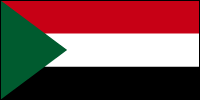| Country (long form) |
Republic of the Sudan |
| Capital |
Khartoum |
| Total Area |
967,498.65 sq mi
2,505,810.00 sq km
(slightly more than one-quarter the size of the US) |
| Population |
36,080,373 (July 2001 est.) |
| Estimated Population in 2050 |
84,192,309 |
| Languages |
Arabic (official), Nubian, Ta Bedawie, diverse dialects of Nilotic, Nilo-Hamitic, Sudanic languages, English |
| Literacy |
46.1% total, 57.7% male, 34.6% female (1995 est.) |
| Religions |
Sunni Muslim 70% (in north), indigenous beliefs 25%, Christian 5% (mostly in south and Khartoum) |
| Life Expectancy |
55.85 male, 58.08 female (2001 est.) |
| Government Type |
transitional - ruling military junta took power in 1989; government is dominated by members of Sudan's National Islamic Front (NIF), a fundamentalist political organization, which uses the National Congress Party (NCP) as its legal front |
| Currency |
1 Sudanese dinar (SD) = 100 piastres |
| GDP (per capita) |
$1,000 (2000 est.) |
| Industry |
cotton ginning, textiles, cement, edible oils, sugar, soap distilling, shoes, petroleum refining, pharmaceuticals, armaments |
| Agriculture |
cotton, groundnuts (peanuts), sorghum, millet, wheat, gum arabic, sugarcane, cassara, mangos, papaya, bananas, sweet potatoes, sesame; sheep, livestock |
| Arable Land |
5% |
| Natural Resources |
petroleum; small reserves of iron ore, copper, chromium ore, zinc, tungsten, mica, silver, gold, hydropower |
|


|